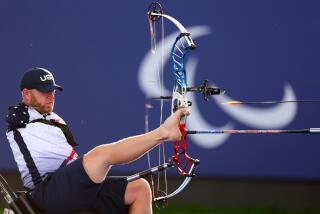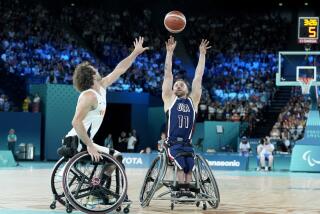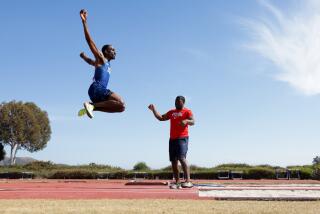Kung Fu Expert Is a Blur of Fists and Wheels
When Ron Scanlon demonstrates his fighting skills, he keeps up a continuous, easy patter, like a magician going through his paces.
“You see, it doesn’t matter if you’re standing, sitting or lying down,” he says, relaxed but alert in his wheelchair. “Fighting is the same. You can break his wrist. . . .”
Ben Smith, tonight’s “opponent,” slashes at Scanlon’s face. Scanlon leans back, grabbing Smith’s arm and twisting it like a pipe wrench. Smith hits the mat like a wet rag.
”. . . You can break his arm. . . .” Smith charges again, and Scanlon smashes his arm against the wheelchair’s armrest.
”. . . You can break his thumb. . . .” Another impetuous charge brings another twisting maneuver, leaving Smith in a heap on the mat.
Paralyzed from the waist down since he was 9, Smith, now 32, is just getting warmed up. He has been laying waste to opponents since he was 17, when he first showed up at Bill Lasiter’s little martial arts studio on Holt Boulevard in Ontario. The chop-and-grunt discipline is a demanding one, he says, with grueling physical conditioning and exacting sparring exercises.
After 15 years at it, he is a master kung fu practitioner, an eighth-degree black belt who teaches self defense to other people with disabilities at the Casa Colina Centers for Rehabilitation in Pomona.
At the 66-bed rehabilitation hospital, where Scanlon puts patients with brain injuries or spinal cord injuries through their paces, he’s a rolling role model, a supremely confident paraplegic who has never acknowledged that he has a “disability.” At Lasiter’s storefront studio, where Scanlon has worked as an instructor, he’s the resident phenom. As he maneuvers the wheelchair around the mats, the green belts and white belts keep a respectful distance.
“For me, being in a wheelchair was an advantage,” insists Scanlon, who was paralyzed after breaking his back in an automobile accident. “I think it gave me confidence as an individual.”
Is he good? “He’s the first handicapped person I’ve ever seen who can teach upright people,” says Lasiter, Scanlon’s teacher for 15 years. “He doesn’t have the use of his legs but he can teach people how to kick.”
A less independent person probably wouldn’t have achieved half as much. From the start of his life as a paraplegic, Scanlon got a taste of some fusty old attitudes toward the disabled, he says.
Fresh out of the hospital, he was relegated to a school for the handicapped in his hometown of Upland. School administrators put him on an easygoing academic track, where he didn’t even have to do his homework, he says. For physical education, they gave him meaningless archery practice, positioning him a few feet from the target.
“You couldn’t miss,” says Scanlon, a brawny man from the waist up, with electric blue eyes and a thatch of dun-colored hair. “There was no skill building, nothing to build self-esteem.”
It was a bitter pill for the youngster, who by then was ranging freely in his wheelchair, playing sandlot baseball and sometimes brawling with other teen-agers. He had developed an adolescent defensiveness about being in a chair. “It’s the same as if people were always teasing you about wearing glasses,” he says. “Sooner or later you’re going to pop somebody.”
Lasiter remembers the day Scanlon first showed up at the martial arts studio. “He had wheeled over from Upland, about six or seven miles,” he says. “He was sitting there watching. I said, ‘Why don’t you join?’ He said, ‘Me?’ ”
“I got bit by it,” says Scanlon. “I’d wheel down for the afternoon class, then stay on for evening class.”
Scanlon, who eventually was admitted to Upland High School and went on to Chaffey Junior College, still loves contact sports. He’s a member of the Casa Colina Condors, national wheelchair basketball champions last year. And he plans to play later this month in the annual “Blister Bowl,” a scrappy game of wheelchair football in a Santa Barbara parking lot.
Kung fu san soo, based on centuries-old fighting techniques from China, Japan and Okinawa, is a punishing means of self-defense, greeting attackers with kicks to the groin, knees to the spine and fingers to the eye. It’s particularly adaptable to the wheelchair-bound, who can use parts of their chairs as weapons, “stomping” with the front wheels or “kneeing” with the edges.
“There’s no particular fighting stance,” Scanlon says. “You fight from whatever position you’re in. If somebody breaks into your house while you’re in bed and grabs you around the throat, you can’t say, ‘Wait a minute, let me get into my stance.’ ”
It’s also a great way to widen a disabled person’s horizons, Scanlon says. He tells of a young woman with muscular dystrophy who was wheeling down Hollywood Boulevard when a man attacked her.
“He came up from behind and tried to pull her top off,” he says. “She backed him into a wall, forced him around in front of her and started chasing him in her wheelchair. She came back to the class with a grin from ear to ear.”
When he works with the disabled, Scanlon is gentle and methodical. A young quadriplegic with limited movement in his arms, sits in the class, slumped motionless in his wheelchair. Scanlon coaxes him forward and soon has him blocking jabs from a volunteer.
“When you’re on the street,” he instructs the young man, “things happen and little red flags should go up. Not that you should be scared or paranoid. Just aware.
“Out on the street,” Scanlon says, “you can’t afford to be a nice guy about it.”
More to Read
Go beyond the scoreboard
Get the latest on L.A.'s teams in the daily Sports Report newsletter.
You may occasionally receive promotional content from the Los Angeles Times.










